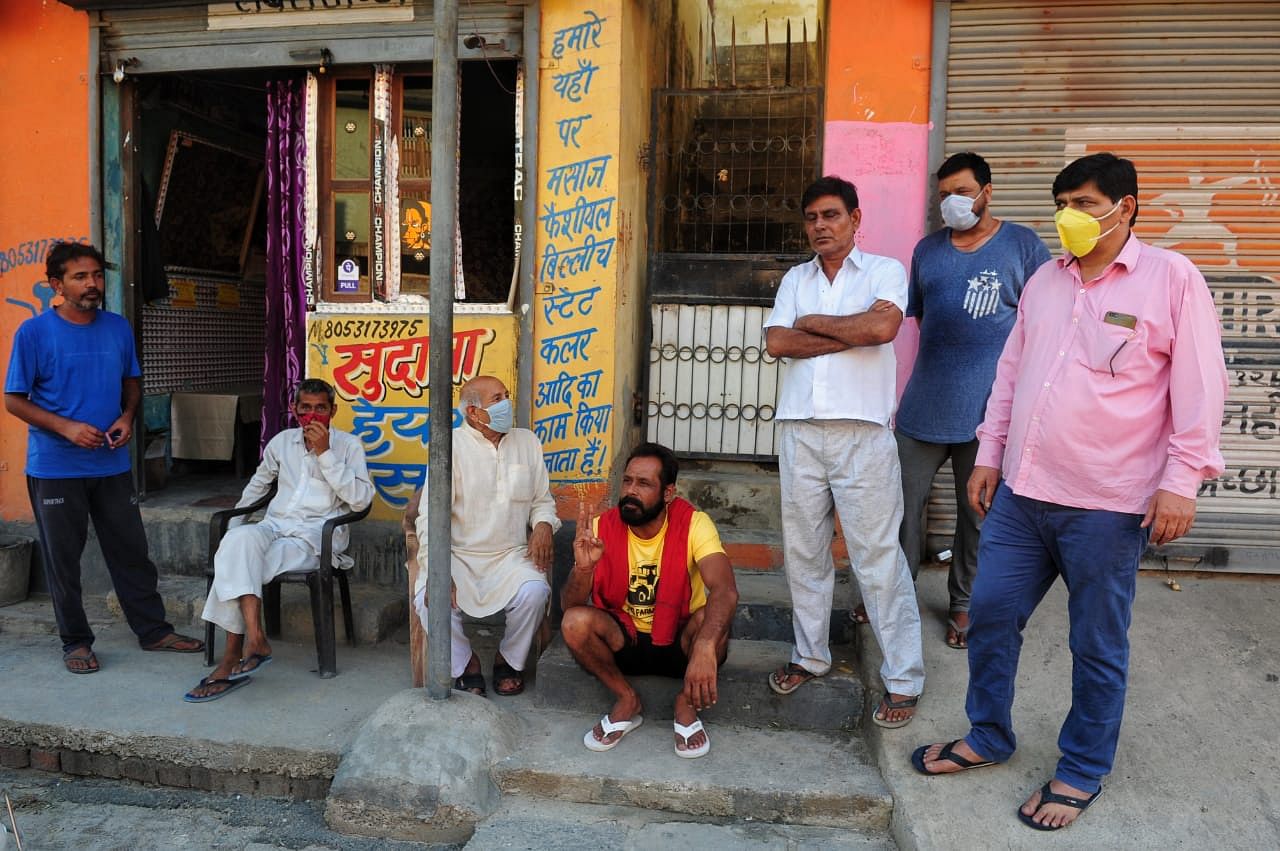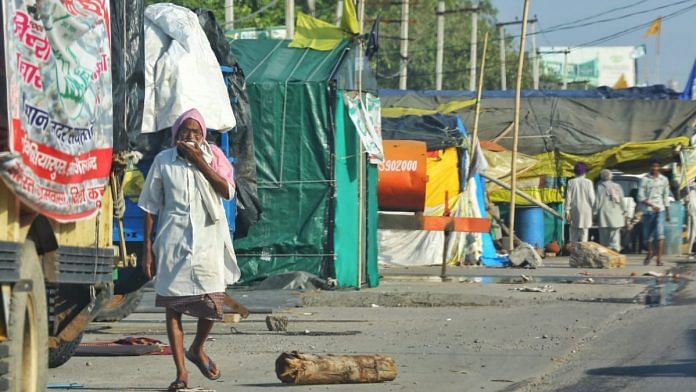Sonipat: Proximity to Delhi, the farmer protests and a ‘delayed lockdown’ all combined to drive up Sonipat’s positivity rate, during the worst of the second wave in April and May.
As of 25 May, Sonipat, the Haryana district bordering the national capital, has 886 active cases and a positivity rate of 3.58 per cent, below the Haryana average of 6.47 per cent.
But at the height of the second wave, the district recorded a case for every second person it tested.
Between 1 May and 7 May, the positivity rate in Sonipat had peaked to 57.6 per cent, second only to Nuh district, which had a positivity rate of 64.3 per cent.
It was even worse than the other prominent Haryana districts in the National Capital Region (NCR) — Faridabad and Gurugram. While Faridabad recorded a positivity rate of 44.5 per cent in that period, Gurgaon’s positivity rate was 36 per cent.
Even before that, Sonipat was struggling. For instance, on 25 April, the district had a positivity rate of 54.71 per cent. On the same day, Haryana’s positivity rate was just 5.95 per cent.
In all, Sonipat recorded 15,392 cases as of 30 March. But between 30 March and 25 May, that figure doubled, with the district recording 30,772 new cases in that period. The death rate also doubled.
As of 30 March, Sonipat had recorded 86 deaths. Since then, it has registered 139 deaths for a cumulative total of 225.
Experts and administrators of the district say such high positivity rates and case-load can be chiefly attributed to the district’s proximity to Delhi.
They also blamed the lack of adherence to Covid protocols, and congested settlements for the district’s woes.
“Lockdown was only implemented on 3 May. But once it was imposed, cases reduced and so has the positivity rate,” Jai Bhagwan, Principal Medical Officer of Civil Hospital, Sonipat, told ThePrint. “It’s free movement, mingling with friends by residents that also contributed to the high positivity rate.”
Also read: ‘Modi, Shah, Khattar hold rallies, meetings but we can’t work?’ Haryana villages boycott lockdown
Proximity to Delhi
According to District Commissioner (DC) Shyam Lal Poonia, more than one lakh people commute to and fro from Sonipat to Delhi every day.
He said they do so for various reasons — from supplying fruits and vegetables to the city to doing day jobs in the capital.
“People from the district commute to Delhi daily as medical and government workers, to sell vegetables, fruits, milk and for other businesses,” Poonia told ThePrint. “This proximity to the capital has also led to the high number of infections in the district.”
Poonia further said that being in Delhi’s vicinity also meant that there was a spillover of cases into Sonipat.
The DC said that towards the end of April, as Delhi’s hospitals ran out of ICU and oxygen beds, Sonipat had to absorb patients coming from the national capital.
“At the peak of the wave, almost 70 per cent of beds in the hospitals were occupied by patients coming from Delhi,” Poonia said. “We never denied admission to patients even if they were from Delhi. Everyone was given help. However, the district’s infrastructure is meant to support patients from here. When patients from even Delhi started pouring in, it became difficult to handle.”
Jai Bhagwan, the Principal Medical Officer of the civil hospital, said the district also saw patients from Rohtak and Jhajjar.
“Since our hospital has an oxygen plant of its own, and the district had ramped up oxygen production, we saw patients coming from Rohtak, Jhajjar and other districts too,” he said. “Even now, about 10-15 per cent of the total beds in the hospital have been occupied by patients coming from other districts.”
Farmer protests at Singhu border
Poonia further said that the farmers’ protest at the Singhu border, which falls in Sonipat district, was also responsible for the Covid spread.
He claimed that the district administration has so far distributed 7,000 paracetamol tablets, one lakh masks and thermally scanned around 50,000 people at the border.
“Around 7,000 tablets of paracetamol were given. You take that on an average, one person took five tablets, then we can assume around 1,400 people at the border were experiencing fever,” the DC said. “A lot of people from Punjab, a high burden state, come there daily and interact with the population of Sonipat. That has also led to the high positivity rates here.”
At the villages bordering Delhi, the farmers and residents admit that they interact with each other.
While farmers keep coming into the villages, the villagers keep going to the protest site to participate in the protest and to eat langar.
“Due to road restrictions, traffic has been diverted to our village. Even though we’re not mingling amongst ourselves also lately, when they (farmers) come seeking directions or any other help, we never turn them down. How can we?” said 41-year-old Manjit Singh, a resident of Janti Kalan village in Sonipat.
According to the village’s Sarpanch Jasbir Singh, more than 16 people have died in the village within a month.
“Everything was quiet and then all of a sudden gaon mein hahakaar mach gaya (there was chaos and death in the village). Every other house had a case of fever,” said Ravinder Prasad, a resident of the village who works as a lab technician in Delhi.
“But at the protest site, there were hardly any corona cases. Why is this happening? I don’t understand this,” he added.

Less testing in rural areas
The administration, however, still hasn’t been able to measure the true magnitude of the pandemic in the district due to its testing rates.
While it alleges that residents are reluctant to get tested, those in rural areas claim that the administration does not conduct enough tests.
Amid this, there have been allegations of the administration undercounting deaths.
For instance at Sisana village, some 25 km from Sonipat, the official Covid death count is two. But according to news reports as well as villagers, more than 40 people died of Covid-like symptoms in a nine-day period starting 25 April.
“No testing happens here. We’ve to go all the way to Sonipat if we want to get tested. Only once was a testing camp organised after the villagers demanded one,” said Shiv Kumar Namburdar, a resident of Sisana village.
“But I tell you what, even when such camps happen, half of us don’t get to know about it since there’s no awareness generated for people to go get tested,” he added. “We don’t even know if people have died of corona or something else.”
The district Covid-19 nodal officer, Nitin Phalswan, however, disagreed and said four testing drives were conducted in the village in 10 days.
District Commissioner Poonia told ThePrint that the administration has tried its best to ramp up testing. “We’ve formed 53 teams to conduct testing all over the district and have tried our best to ensure the sampling is broad based and representative,” DC Poonia said. “Testing has been ramped up too. From 9,659 tests that we conducted between 1 to 3 May, it was increased to 18,171 tests conducted between 19 to 22 May.”
Since hitting the peak, Sonipat’s positivity rate has shown a downward trend. On 25 May, the positivity rate was 3.58 per cent. Haryana’s stood at 6.47 per cent.
Since 1 May, the district has consistently increased testing and witnessed a decline in cases.
On 1 May, Sonipat conducted 2,261 tests, which yielded 936 positive results. This increased to 4,047 tests on 24 May, and positive results stood at 145.
While zero rapid antigen tests were conducted in the district on 1 April, these have been increased to 1,756 as of 24 May.
The district administration had conducted 1,223 RT PCR tests as of 1 April but this increased to 2,291 as of 24 May.
(Edited by Arun Prashanth)
Also read: Protesting farmers call Covid ‘govt conspiracy’ as Haryana blames them for surging deaths



